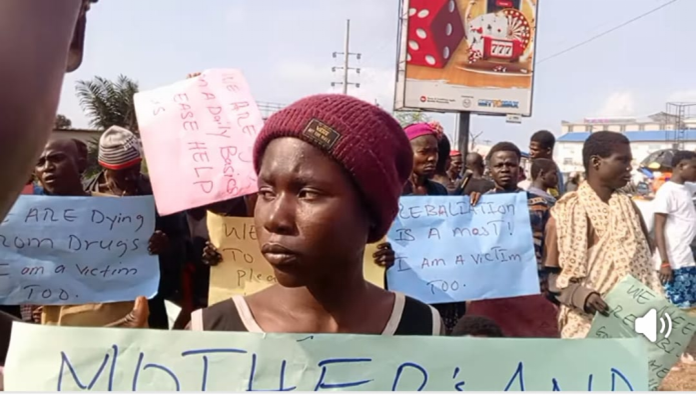The streets of Paynesville, Liberia, resonated with the cries of hundreds of disadvantaged youth, known locally as “zogoes,” as they marched from the notorious drug hub of King Gray community to the Samuel K. Doe Sports Complex. Their protest was a desperate plea to the government for intervention in the pervasive drug crisis gripping their lives and communities, a crisis fueled by poverty, social neglect, and the readily available supply of illicit substances. Carrying placards bearing messages of despair and hope, they chanted slogans like “No more drugs,” and “Rehabilitation is a must,” their voices amplified by the weight of unfulfilled promises and the urgency of their situation. These young people, victims of circumstance and addiction, were demanding not just an end to the drug trade but a chance at recovery, a path back to their families and a place within society. Their demonstration underscored the deep-seated frustration with the government’s perceived inaction and the escalating need for comprehensive rehabilitation programs.
The protest unfolded against the backdrop of a recent police raid in King Gray Graveyard, where numerous zogoes and suspected drug dealers were arrested. The operation, however, was marred by controversy as police and unidentified individuals were observed forcibly cutting the hair of detainees, both male and female, an act that sparked public outrage and further fueled the zogoes’ discontent. This incident highlighted the often-heavy-handed approach taken by law enforcement in addressing the drug problem, an approach that often targets the victims of addiction rather than the root causes or the suppliers. The zogoes’ protest was a direct challenge to this approach, demanding not punishment but support, not further marginalization but genuine efforts at reintegration.
A representative from the Ministry of Youth and Sports addressed the protesters, acknowledging the gravity of the drug crisis and the widespread impact of addiction on over 100,000 young people across the nation. He affirmed the ministry’s commitment to tackling the issue, citing a pre-existing work plan designed to address this very problem. He assured the demonstrators of the government’s intention to reach out to those willing to undergo rehabilitation, offering a glimmer of hope amidst the despair. However, the zogoes’ protest, and the larger context of community-led actions against drug use, pointed to a growing impatience with the pace of government action. While the official’s acknowledgment was a step in the right direction, the protesters, and indeed the affected communities, were demanding tangible action, concrete programs, and visible results.
The zogoes’ demonstration was not an isolated incident but part of a broader national movement against drug abuse. Communities across Monrovia, including Saye Town and 12th Street in Sinkor, had taken matters into their own hands, dismantling local drug dens and driving away suspected users. While these actions reflected a growing public determination to combat the drug menace, they also raised concerns about potential human rights abuses and the need for coordinated, lawful interventions. The government, while acknowledging the community’s concerns, urged citizens to collaborate with the Joint Security of Liberia to ensure that anti-drug efforts remained within the bounds of the law and respected the rights of all individuals.
The rising tide of anti-drug sentiment culminated in a “Say No to Drugs” march on August 7, 2025, where hundreds converged at the Capitol Building to demand immediate government action. The following day, President Joseph Boakai announced a new set of anti-drug policies, including a directive urging citizens to report drug-related activities directly to the Liberia Drug Enforcement Agency (LDEA). While these policy announcements signaled a commitment at the highest level of government, the effectiveness of these measures remained to be seen. The zogoes’ protest served as a powerful reminder that policies alone were insufficient, and that genuine change required a multi-pronged approach that encompassed prevention, treatment, and reintegration.
The protest by the zogoes in Paynesville marked a significant turning point. It represented a powerful shift in the narrative surrounding drug abuse in Liberia. These marginalized youths, often stigmatized and overlooked, were stepping forward and demanding to be heard. They were not only protesting against drugs but also advocating for their own rehabilitation and reintegration into society. Their message was clear: the fight against drugs must include, not exclude, the victims. It must prioritize rehabilitation, provide humane policing strategies, and offer long-term social support. Only through such a comprehensive approach could Liberia hope to break the vicious cycle of addiction, poverty, and marginalization that had ensnared so many of its young people. The protest was a call for a more compassionate and effective strategy, one that recognized the humanity of those struggling with addiction and offered them a pathway to recovery and a future free from the grip of drugs.


